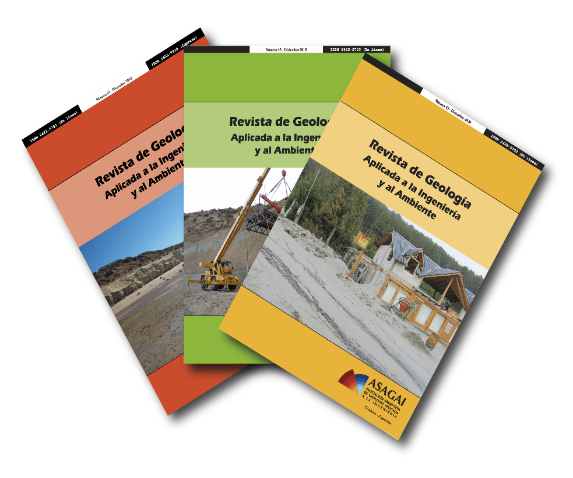Suitability of compacted tropical soils for the construction of insulating barriers in sanitary landfills in Argentina
DOI:
https://doi.org/10.59069/24225703ee014Keywords:
residual tropical soils, landfill, compaction, hidraulic conductivityAbstract
The main objective of bottom and side barriers in sanitary landfills is to prevent the migration of leachates from the interior to the exterior. These liners should be designed by taking into account mechanical and hydraulic properties. In many cases, to reduce costs, local soils are used as construction materials for this purpose. However, due to the great variability in the hydromechanical properties of soils, the design of lines should consider the local conditions of each location. This article analyzes the possibility of using compacted residual soils and evaluates the variability of compaction parameters to determine the optimal construction conditions to meet international specifications for geological barriers for landfills
References
Albright, W. H., Benson, C. H., Gee, G. W., Abichou, T., Tyler, S. W., y Rock, S. A. (2006). Field performance of three compacted clay landfill covers. Vadose Zone Journal, 5(4), 1157-1171.
https://doi.org/10.2136/vzj2005.0134
ASTM D698-(2015) Standard Test Methods for Laboratory Compaction Characteristics of Soil Using Standard Effort (12,400 ft-lbf/ft3 (600 kN-m/m3))
ASTM D5856-(2015) Standard Test Method for Measurement of Hydraulic Conductivity of Porous Material Using a Rigid-Wall, Compaction-Mold Permeameter.
ASTM D7181-(2020) Standard Test Method for Consolidated Drained Triaxial Compression Test for Soils.
Ayetey, J. K., Frempong, E. M. (1996). Engineering soils mapping in the tropical terrain: The Ghana experience. Bulletin of the International Association of Engineering Geology, (54), 33-43. https://doi.org/10.1007/BF02600652
Benson, C. H., Trast, J. M. (1995). Hydraulic conductivity of thirteen compacted clays. Clays and clay minerals, 43(6), 669-681.
https://doi.org/10.1346/CCMN.1995.0430603
Blight, G. E., y Leong, E. C. (Eds.). (2012). Mechanics of residual soils. CRC Press. https://doi.org/10.1201/b12014
Bogado, G. O., Reinert, H. O., y Francisca, F. M. (2019). Geotechnical properties of residual soils from the North-east of Argentina. International Journal of Geotechnical Engineering, 13(2), 112-121. https://doi.org/10.1080/19386362.2017.1326682
Daniel, D. E. (1993). Clay liners. In Geotechnical practice for waste disposal (pp. 137-163). Springer, Boston, MA.
Daniel, D. E., y Wu, Y. K. (1993). Compacted clay liners and covers for arid sites. Journal of Geotechnical Engineering, 119(2), 223-237. https://doi.org/10.1061/(ASCE)0733-9410(1993)119:2(223)
Fookes, P. G. (Ed.). (1997). Tropical residual soils: A Geological Society Engineering Group working party revised report. Geological Society of London. https://doi.org/10.1144/GSL.QJEG.1990.023.001.01
Francisca, F. M., y Glatstein, D. A. (2010). Long term hydraulic conductivity of compacted soils permeated with landfill leachate. Applied Clay Science, 49(3), 187-193. https://doi.org/10.1016/j.clay.2010.05.003
Francisca, F. M., y Bogado, G. O. (2019). Weathering effect on the small strains elastic properties of a residual soil. Geotechnical and Geological Engineering, 37, 4031-4041. https://doi.org/10.1007/s10706-019-00891-4
Francisca, F. M., Mozejko, C. A. (2022). Hydraulic and mechanical behavior of compacted silts modified by waste steel slag. Geomechanics for Energy and the Environment, 32, 100323. https://doi.org/10.1016/j.gete.2022.100323
Günayd?n, O. J. E. G. (2009). Estimation of soil compaction parameters by using statistical analyses and artificial neural networks. Environmental Geology, 57(1), 203-215.7 https://doi.org/10.1007/s00254-008-1300-6
Guney, Y., Cetin, B., Aydilek, A. H., Tanyu, B. F., y Koparal, S. (2014). Utilization of sepiolite materials as a bottom liner material in solid waste landfills. Waste Management, 34(1), 112-124. https://doi.org/10.1016/j.wasman.2013.10.008
Jayawardhana, Y., Kumarathilaka, P., Herath, I., y Vithanage, M. (2016). Municipal solid waste biochar for prevention of pollution from landfill leachate. In Environmental materials and waste (pp. 117-148). Academic Press. https://doi.org/10.1016/B978-0-12-803837-6.00006-8
Kang, J. B., y Shackelford, C. D. (2010). Membrane behavior of compacted clay liners. Journal of Geotechnical and Geoenvironmental Engineering, 136(10), 1368-1382. https://doi.org/10.1061/(ASCE)GT.1943-5606.0000358
Mitchell, J. K., y Soga, K. (2005). Fundamentals of soil behavior (Vol. 3, p. USA). New York: John Wiley & Sons.
Montoro, M. A., y Francisca, F. M. (2010). Soil permeability controlled by particle–fluid interaction. Geotechnical and Geological Engineering, 28(6), 851-864.
https://doi.org/10.1007/s10706-010-9348-y
Musso, T. B., Francisca, F. M., Parolo, M. E., y Roehl, K. E. (2013). Potential use of calcareous mudstones in low hydraulic conductivity earthen barriers for environmental applications. Environmental technology, 34(17), 2465-2476.
https://doi.org/10.1080/09593330.2013.772660
Musso, T. B., Pettinari, G. R., y Francisca, F. M. (2012). Aptitud de dos sedimentitas rojas cretácicas del departamento Confluencia, Neuquén, para ser usadas como barreras aislantes en rellenos sanitarios. Revista de Geología aplicada a la Ingeniería y el Medio Ambiente
Öncü, ?., y Bilsel, H. (2017). Effect of zeolite utilization on volume change and strength properties of expansive soil as landfill barrier. Canadian Geotechnical Journal, 54(9), 1320-1330.
https://doi.org/10.1139/cgj-2016-0483
Osinubi, K. J., y Nwaiwu, C. M. (2006). Design of compacted lateritic soil liners and covers. Journal of geotechnical and geoenvironmental engineering, 132(2), 203-213.
https://doi.org/10.1061/(ASCE)1090-0241(2006)132:2(203)
Osinubi, K. J., y Nwaiwu, C. M. (2005). Hydraulic conductivity of compacted lateritic soil. Journal of geotechnical and geoenvironmental engineering, 131(8), 1034-1041.
https://doi.org/10.1061/(ASCE)1090-0241(2005)131:8(1034)
Sharma, H. D., y Reddy, K. R. (2004). Geoenvironmental engineering: site remediation, waste containment, and emerging waste management technologies. John Wiley & Sons.
Taha, M. R., y Kabir, M. H. (2005). Tropical residual soil as compacted soil liners. Environmental Geology, 47(3), 375-381.
https://doi.org/10.1007/s42452-019-0475-7
VN-E6-1984 Determinación del valor soporte e hinchamiento de suelos. Normas vialidad Nacional Argentina.
Watabe, Y., Yamada, K., y Saitoh, K. (2011). Hydraulic conductivity and compressibility of mixtures of Nagoya clay with sand or bentonite. Géotechnique, 61(3), 211-219.
https://doi.org/10.1680/geot.8.P.087
Wesley, L. D. (2009). Fundamentals of soil mechanics for sedimentary and residual soils. John Wiley & Sons. ISBN: 978-0-470-54905-6
Wesley, L. D. (2010). Geotechnical engineering in residual soils. John Wiley & Sons. DOI:10.1002/9780470943113
Zhan, L. T., Ni, J. Q., Feng, S., Kong, L. G., y Feng, T. (2022). Saturated hydraulic conductivity of compacted steel slag-bentonite mixtures——A potential hydraulic barrier material of landfill cover. Waste Management, 144, 349-356. https://doi.org/10.1016/j.wasman.2022.04.004
Downloads
Published
Issue
Section
License
Copyright (c) 2024 Gustavo Orlando Bogado, Hugo Orlando Reinert, Franco Matías Francisca, Carlos Enrique Schvezov

This work is licensed under a Creative Commons Attribution-NonCommercial-ShareAlike 4.0 International License.
Attribution - Non-Commercial - Share Alike (by-nc-sa): No commercial use of the original work or any derivative works is permitted, distribution of which must be under a license equal to that governing the original work.










